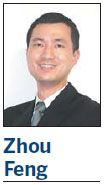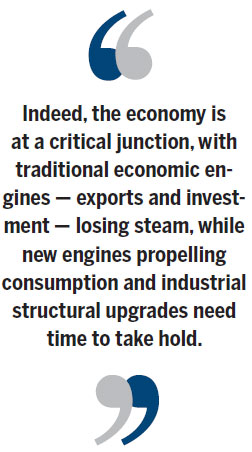A fresh change of pace
Updated: 2015-04-17 07:01
By Zhou Feng(China Daily Europe)
|
|||||||||||
The economy will have limited room to maneuver if there are no new growth engines
The Chinese economy got off to a bad start this year. According to the National Bureau of Statistics, the world's second-largest economy grew 7 percent in the first quarter, the worst quarterly performance since the fourth quarter of 2008, causing concerns that the country may miss its yearly GDP growth target of 7 percent set by the central government last month, if slowdown continues.
Fixed-asset investment, a key driver of the economy, grew 13.5 percent in the first quarter of the year, the weakest expansion in the first three months of a year since 2000. In addition, investment in the property industry grew only 8.5 percent in the first quarter, the first single-digit growth in years. Retail sales growth continued to moderate at 10.6 percent.
While it is obvious that the Chinese economy is slowing down, the question is where the bottom is.

Looking at the short term, it is likely that GDP growth will bottom out in the second quarter. However, over the long term, we can safely say that the economy can only regain its momentum if the country can find a new economic engine.
So what is influencing the Chinese economy? One factor is the central government's policy stance.
Since the government has a large influence on the economy through its state-owned enterprises and financial system, its policy stance will greatly shape the direction of the economy. But what is the government's stance?
There are clear indications that central and local policymakers have loosened fiscal and monetary policies in recent weeks amid growing worries of a deeper economic slowdown.
During his trip over the past few days to Changchun, capital of Jilin province, Premier Li Keqiang expressed his disappointment with Northeast China's slowing economic growth, stressing that growth is the foundation with which to improve people's lives, employment and income. The three provinces in the region - Liaoning, Jilin and Heilongjiang - registered GDP growth of 5.8 percent, 6.5 percent and 5.6 percent last year, far behind the national average.
His attitude and comments were a clear turnabout compared with a year ago. In March 2014, during a trip to Liaoning, local officials told Li about the mounting pressures of maintaining its regional economic growth, and he spoke of the importance of reform instead of economic growth.
Times have changed, and so has the mindset of top policymakers, who clearly do not want economic growth to bottom out.
To that end, it is expected that fiscal measures such as investment in mega-infrastructure projects will be taken. At the same time, national monetary policy will be loosened even further, with at least one more round of interest rate cuts in the second quarter following the most recent one on March 1.
Policymakers also appear to have reached a consensus on the need to boost two traditional economic engines - the property and stock markets.

A slew of policies - such as reducing the down payment ratio for second homes from 60 percent to 40 percent and loosening the requirement to access housing provident funds - are all clearly aimed at shoring up the property market.
As for the stock market, last month central bank governor Zhou Xiaochuan said he did not think that capital flowing to the stock market was a bad thing. His remarks served as a clear indication of support for the stock market. Previously, many officials and economists were saying that a bullish equity market grabbed limited financial resources from manufacturing and services industries and created bubbles. With government backing of the stock market, it is likely that more idle money will be activated through the stock market to benefit the economy.
Based on the understanding that the government adopts a pro-growth stance and continues to roll out supporting measures, it is likely that economic growth will stabilize and recover in the second quarter.
However, in the long run the government will have limited room to maneuver if there are no new engines to propel the Chinese economy.
Indeed, the economy is at a critical junction, with traditional economic engines - exports and investment - losing steam, while new engines propelling consumption and industrial structural upgrades need time to take hold.
Within this transitional period, the government may need to strike a balance in economic growth, which is needed to ensure employment, restructuring and new growth potential.
The author is a Shanghai-based financial analyst. The views do not necessarily reflect those of China Daily.
(China Daily European Weekly 04/17/2015 page10)
Today's Top News
AIIB to operate in 'transparent way'
PLA to buy advanced missiles from Russia
EU accuses Google of hurting consumers, competitors
Q1 economic data: what the economists say
Holocaust memories to live on
Problem-plagued Milan Expo battles a long list of headaches
Foreign ministers call for end to fighting in east Ukraine
Spotlight set to shine on royal sibling
Hot Topics
Lunar probe , China growth forecasts, Emission rules get tougher, China seen through 'colored lens', International board,
Editor's Picks

|

|

|

|

|

|






